Classic garden ideas
Homes & Gardens shows you how to design your own classic garden using statues, topiary, urns, formal planting and more.
Most of us, when we loosely describe a garden as "classic", have in mind something that is manicured, clipped, controlled, tidy. If pushed to name specific elements we expect to find in such a garden, we would all probably list topiary, fountains and pools, statuary and pots, pergolas, expanses of lawn and stone and, when pushed further still, we would imagine these elements arranged in a formal, generally symmetrical way. All of these can in fact be traced, in one way or another, back to ancient Roman gardens, and our use of them today is only the latest in a long line of interpreting a look that could be more correctly described as Classical.
Parterres are a typical element of this garden design style, and many impressive examples were created during the Renaissance, a heyday for Classical gardens throughout Europe. The stunning boxwood parterre seen here, part of the gardens at Restoration House in Kent, was in fact planted in the 1990s.
1/20 What is a classic garden?
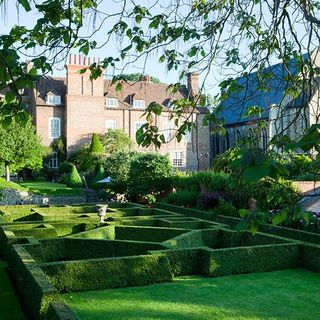
Don't miss these brilliant garden ideas.
Visitor information
Restoration House
2/20 The terrace
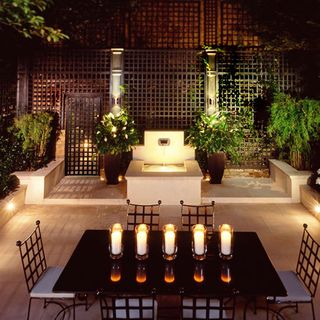
Stone-flagged terracing is another typical design feature of the Classical garden, and it is a format that can be easily transposed to fit a small space. For such a garden not only to look good, but also to be safe, comfortable and to stay looking good through all weathers, you need to choose the best possible materials and to pay for the best possible professionally qualified contractors to design and install them. It is not a garden style to undertake lightly, so make sure you have fully researched all your costs before you spend any of your budget.
Expert advice on hardscaping for gardens
See p178-179 of the April 2013 issue of Homes & Gardens, available from the App Store and Zinio
Landscape architect
Richard Sneesby
3/20 Double-depth herbaceous borders
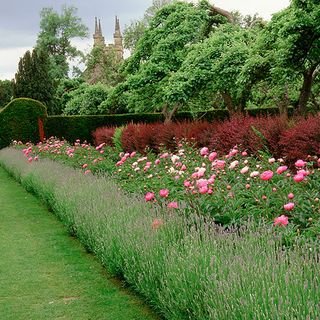
With an emphasis on planting rather than hard elements, the trend for creating double-depth borders reached its heyday here in Britain during the Edwardian period. A major feature of country houses across the land, the borders were planted with herbaceous perennials intended to be in full flower during the summer months when the homeowners would be present for the holidays.
Get the Ideal Home Newsletter
Sign up to our newsletter for style and decor inspiration, house makeovers, project advice and more.
The sheer size of these borders required hundreds of plants to fill them, and a large number of gardeners to maintain them, so as financial and physical resources - as well as garden style - tightened, so the traditional double-depth border began to disappear from most gardens.
Where to see double-depth borders
Levens Hall and Newby Hall
4/20 Using the unusual and unexpected
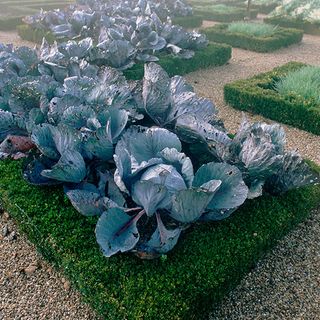
Classical gardens are filled with all sorts of weird and wonderful ideas, from cabbages used as bedding plants to infill the vast parterres at Château Villandry (pictured), to the fantastical creatures carved from stone that randomly populate the woodland glades and water features of the gardens at Bomarzo, Italy. Be adventurous with your choice of plants or garden accessories, but display them in a formal manner for maximum classical style.
Visitor information
Château Villandry
Bomarzo
5/20 Pots and urns
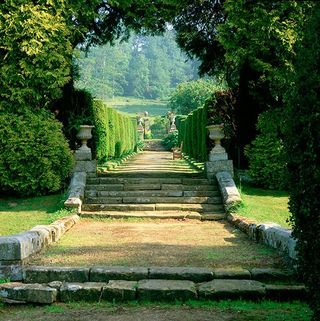
Pots and urns can be used as punctuation marks throughout a classical garden, raised up on pedestals or lined up along a walk. You can mix shapes and styles in the garden as a whole, but for maximum symmetrical effect, identical pairs work best.
Similar stone urns
Haddonstone
6/20 Topiary

The gardeners of Ancient Rome were slaves, and those who looked after the ornamental garden (topia) were called topiarius, from which the word topiary is derived. Yew and box are the perennial plant of choice for topiary, but you can clip and hard prune a number of other evergreens, including privet, laurel and holly.
Topiary book
The Art of Creative Pruning: Inventive Ideas for Training and Shaping Trees and Shrubs by Jake Hobson, Timber Press
7/20 Artifice and architectural elements
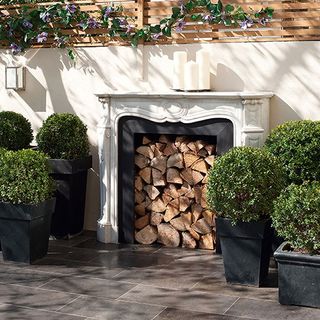
Just as we use the walls and spaces inside our homes to display art and favoured possessions, and use fixtures and fittings to turn a house into a home, so the gardener as artist uses similar pieces to turn a patch of open space into a garden of dreams. This marble fire surround as log store is the modern equivalent of Pirro Ligorio?s 16th-century designs for the spectacular and bizarre water fountains in the gardens at Villa d?Este, Tivoli, where galleons sail on ponds and an "organ" plays as water pours through its pipes.
Visitor information
Villa d?Este, Tivoli, Italy
Salvaged marble fire surrounds
Renaissance London
8/20 Viewing points
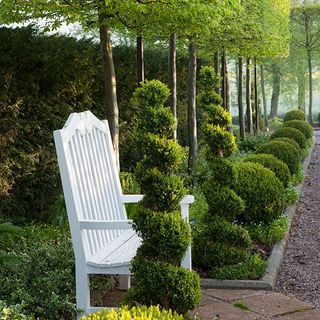
Garden-making has long been regarded as an art form, and the final result something that should be applauded and enjoyed; any classical garden worth its salt, therefore, included very deliberately planned viewing points, places from where the owner and his guests could stop and enjoy the most spectacular of all the effects created in the garden, as well as keep an eye on the fruits of his (or his gardeners?) labours.
For bespoke garden benches
Stuart Garden Architecture
9/20 The formal and the informal

The boundary between where a formal or classical, manicured garden stops and the rougher, more natural, unmanicured countryside begins needs to be considered as part of your overall design. It is not just about putting up a fence and shielding or hiding the area beyond from view; the Classical gardener works with the wider surroundings, borrowing and sharing elements to create a visual - perhaps even a physical - link between the two spaces. An apsidal-shaped row of pleached hornbeam here provides a natural but manmade barrier between formal and informal, with topiaried box positioned beneath as a nod to the naturally shaped shrubs and trees in the distance. The obelisk is the ultimate end point.
Selection of stone obelisks
Chilstone
10/20 Ivy and arches
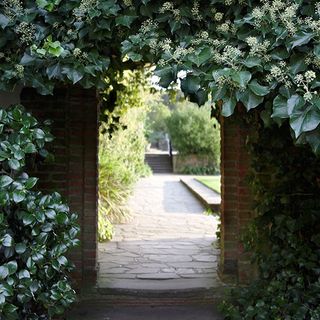
Atmospheric, low-maintenance, quick to grow and a sucker for brickwork, the hardy evergreen ivy has a mixed reputation but is ideal for creating an almost instant Classical style. The ivy-covered archway, particularly one that draws the eye to the vista beyond, cannot be beaten. Keep the plants trim; lightly cut back in spring to encourage new growth and take cuttings when the growth is woody (October to March).
Where to buy hederas (ivies)
Burncoose
11/20 Cherry tree walkway
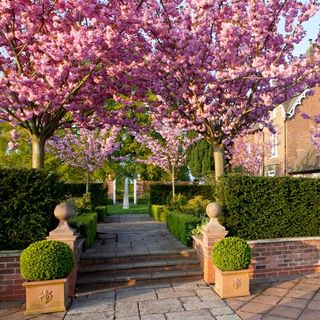
A formal garden should have a clearly defined entrance from the house. Here, Cherry trees in full ephemeral bloom are used to mark the start of the garden, while the use of symmetry and formal lines creates a garden of allées and vistas. The vibrant colour of the Cherry trees also provides a splash of colour amongst the topiary.
Similar planters
The Chelsea Gardener
12/20 Structural shapes
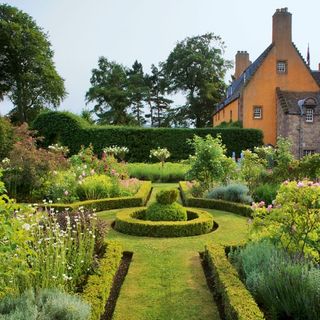
Structured pathways and planting epitomise classic gardens. Creating order, symmetry and instant formality, boxed planting and linear walkways also help to guide the visitor on their journey, while circular shapes soften the look. A walled garden like this takes its inspiration from Renaissance designs.
Similar plants
Crocus
13/20 Formal borders
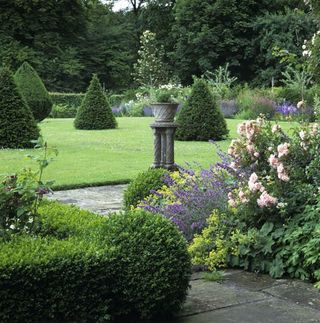
Yew topiary breaks up a large lawn and, combined with formal borders and stone pathways, creates a sense of grandeur and elegance.
Yew topiary
Box
Catmint
Alchemilla
Rosa 'Felicia'
14/20 Tree framework
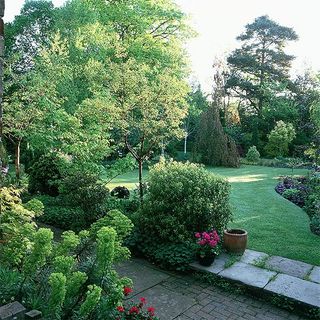
Trees such as birch, fir, copper beech and various acers form the bones of the garden. If you have a strong framework of trees you will find that everything else falls into place.
West Dean in Cobham, is open through the National Garden Scheme.
Birch
Fir Tree
Copper Beech
Acer
15/20 A place to sit
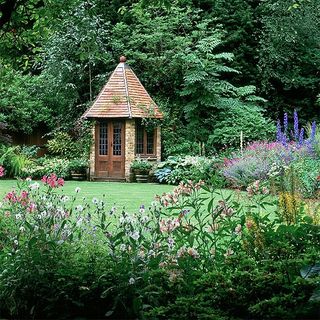
Amid trees and curving beds of ligularia, hydrangea and hosta sits a pretty summerhouse.
Ligularia
Hydrangea
Hostas
Delphiniums
16/20 Box parterre
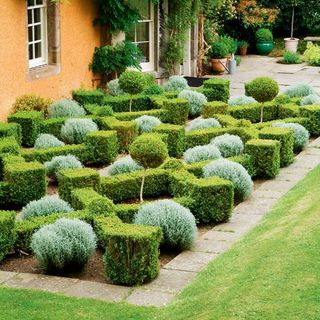
This box parterre is dotted with contrasting tufts of Santolina chamaecyparissus. It creates an eyecatching display to contrast the expanse of lawn.
Santolina chamaecyparissus
Crocus
17/20 Restored greenhouses
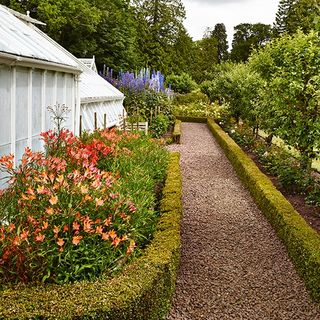
The impressive spires of Delphinium ‘Pacific Giant’ and a profusion of old-fashioned moss roses are an attractive foil to restored greenhouses.
18/20 Box framework
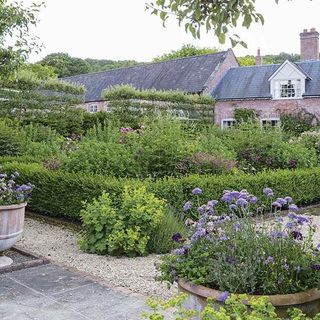
Exuberant planting bursts forth from an ordered geometric framework of box. Statement terracotta planters filled with Scabiosa mark an entrance to the formal garden, and roses and alliums added interest to the box framework.
19/20 Solitary statues
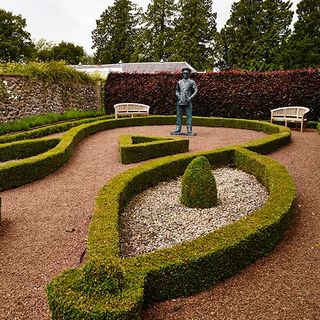
Statues and artworks bring formality to any garden space. Liberate modern works from the confines of a gallery to create a surprising but interesting fit in a traditional garden.
Similar benches
Internet Gardener
20/20 Shelterbelt

A fundamental feature in any classic garden, a Grass Walk can be lined with dense borders full of lupins, Inula, Campanula and meadowsweet. A dense shelterbelt of mature Wellingtonias and other specimen trees added in the late 19th century feature in this two-acre, south-west facing country garden in the Berwickshire hills.
Tamara was Ideal Home's Digital Editor before joining the Woman & Home team in 2022. She has spent the last 15 years working with the style teams at Country Homes & Interiors and Ideal Home, both now at Future PLC. It’s with these award wining interiors teams that she's honed her skills and passion for shopping, styling and writing. Tamara is always ahead of the curve when it comes to interiors trends – and is great at seeking out designer dupes on the high street.
-
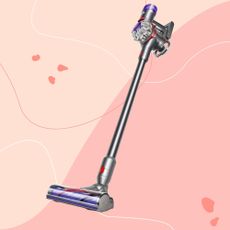 It’s normally impossible to find a Dyson vacuum for under £250 — but QVC has slashed the price of their bestselling models for a limited time
It’s normally impossible to find a Dyson vacuum for under £250 — but QVC has slashed the price of their bestselling models for a limited timeRun don’t walk to pick up the brand’s bestselling model for under £230 before it sells out
By Lauren Bradbury
-
 How to remove algae from a fence — 4 methods that will banish the green and prevent wood rot
How to remove algae from a fence — 4 methods that will banish the green and prevent wood rotYou don’t have to replace a fence if it’s covered in algae. Here's what to do…
By Kayleigh Dray
-
 I wish I'd known about these 4 things before I bought my Le Creuset – here's how you can learn from my mistakes
I wish I'd known about these 4 things before I bought my Le Creuset – here's how you can learn from my mistakesHere's how to make sure your Le Creuset will still be your most-used pan in a decade
By Molly Cleary